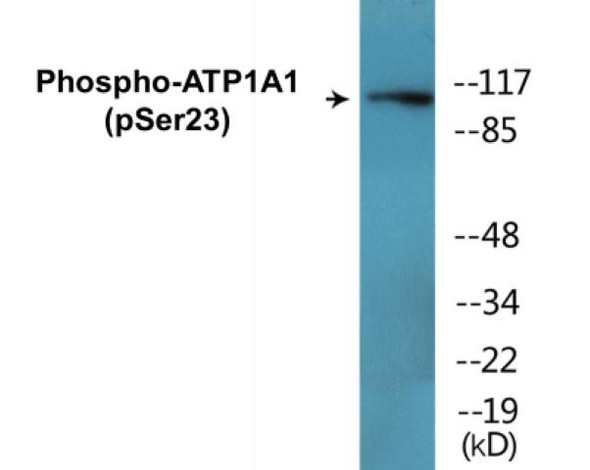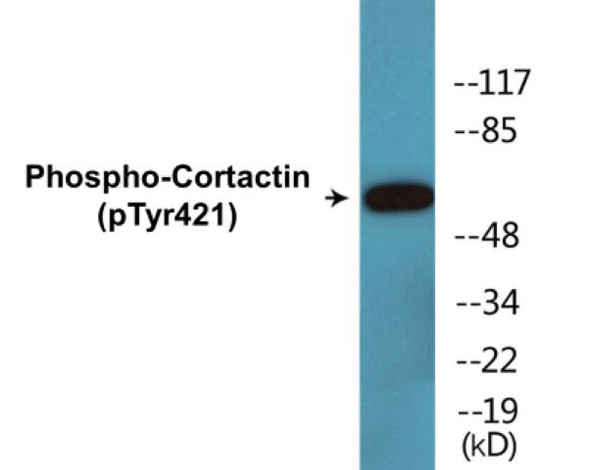WASP (Phospho-Tyr290) Colorimetric Cell-Based ELISA Kit
- SKU:
- CBCAB01329
- Product Type:
- ELISA Kit
- ELISA Type:
- Cell Based Phospho Specific
- Reactivity:
- Human
- Mouse
- Detection Method:
- Colorimetric
Description
WASP (Phospho-Tyr290)Colorimetric Cell-Based ELISA Kit
The WASP Phospho-Tyr290 Colorimetric Cell-Based ELISA Kit is a cutting-edge tool designed for the accurate detection of phosphorylated tyrosine 290 levels in cell lysates and tissue extracts. This kit offers high sensitivity and specificity, ensuring precise and reproducible results for your research needs.Phosphorylation of tyrosine 290 on the WASP protein is a crucial event in the regulation of actin polymerization and cytoskeletal dynamics, playing a key role in cell motility and migration processes. Dysregulation of this phosphorylation event has been implicated in various diseases, including cancer and autoimmune disorders, making it a valuable target for studying disease mechanisms and potential therapeutic interventions.
With the WASP Phospho-Tyr290 Colorimetric Cell-Based ELISA Kit, researchers can accurately measure levels of phosphorylated tyrosine 290 in experimental samples, providing valuable insights into signaling pathways and cellular processes involved in disease development. Trust in this advanced kit for reliable and insightful results in your research endeavors.
| Product Name: | WASP (Phospho-Tyr290) Colorimetric Cell-Based ELISA |
| Product Code: | CBCAB01329 |
| ELISA Type: | Cell-Based |
| Target: | WASP (Phospho-Tyr290) |
| Reactivity: | Human, Mouse |
| Dynamic Range: | > 5000 Cells |
| Detection Method: | Colorimetric 450 nm |
| Format: | 2 x 96-Well Microplates |
The WASP (Phospho-Tyr290) Colorimetric Cell-Based ELISA Kit is a convenient, lysate-free, high throughput and sensitive assay kit that can detect WASP protein phosphorylation and expression profile in cells. The kit can be used for measuring the relative amounts of phosphorylated WASP in cultured cells as well as screening for the effects that various treatments, inhibitors (ie. siRNA or chemicals), or activators have on WASP phosphorylation.
Qualitative determination of WASP (Phospho-Tyr290) concentration is achieved by an indirect ELISA format. In essence, WASP (Phospho-Tyr290) is captured by WASP (Phospho-Tyr290)-specific primary (1ø) antibodies while the HRP-conjugated secondary (2ø) antibodies bind the Fc region of the 1ø antibody. Through this binding, the HRP enzyme conjugated to the 2ø antibody can catalyze a colorimetric reaction upon substrate addition. Due to the qualitative nature of the Cell-Based ELISA, multiple normalization methods are needed:
| 1. | A monoclonal antibody specific for human GAPDH is included to serve as an internal positive control in normalizing the target absorbance values. |
| 2. | Following the colorimetric measurement of HRP activity via substrate addition, the Crystal Violet whole-cell staining method may be used to determine cell density. After staining, the results can be analysed by normalizing the absorbance values to cell amounts, by which the plating difference can be adjusted. |
| Database Information: | Gene ID: 7454, UniProt ID: P42768, OMIM: 300299/300392/301000/313900, Unigene: Hs.2157 |
| Gene Symbol: | WAS |
| Sub Type: | Phospho |
| UniProt Protein Function: | WASP: a member of the Wiskott-Aldrich syndrome (WAS) family of proteins. A cytoplasmic protein expressed exclusively in hematopoietic cells. Transduces signals from surface receptors to the actin cytoskeleton. Associates with the small GTPase, Cdc42, known to regulate formation of actin filaments, and the cytoskeletal organizing complex, Arp2/3. Mutated in Wiskott-Aldrich syndrome, a rare, inherited, X-linked, recessive disease characterized by immune dysregulation and microthrombocytopenia. |
| UniProt Protein Details: | Protein type:Motility/polarity/chemotaxis; Adaptor/scaffold Chromosomal Location of Human Ortholog: Xp11.4-p11.21 Cellular Component: intercellular junction; vesicle membrane; cytosol; actin cytoskeleton Molecular Function:identical protein binding; protein binding; phospholipase binding; actin binding; SH3 domain binding; protein kinase binding Biological Process: epidermis development; T cell activation; actin filament polymerization; regulation of catalytic activity; actin filament-based movement; actin polymerization and/or depolymerization; innate immune response; defense response; protein complex assembly; immune response; endosome transport; blood coagulation; T cell receptor signaling pathway Disease: Thrombocytopenia 1; Neutropenia, Severe Congenital, X-linked |
| NCBI Summary: | The Wiskott-Aldrich syndrome (WAS) family of proteins share similar domain structure, and are involved in transduction of signals from receptors on the cell surface to the actin cytoskeleton. The presence of a number of different motifs suggests that they are regulated by a number of different stimuli, and interact with multiple proteins. Recent studies have demonstrated that these proteins, directly or indirectly, associate with the small GTPase, Cdc42, known to regulate formation of actin filaments, and the cytoskeletal organizing complex, Arp2/3. Wiskott-Aldrich syndrome is a rare, inherited, X-linked, recessive disease characterized by immune dysregulation and microthrombocytopenia, and is caused by mutations in the WAS gene. The WAS gene product is a cytoplasmic protein, expressed exclusively in hematopoietic cells, which show signalling and cytoskeletal abnormalities in WAS patients. A transcript variant arising as a result of alternative promoter usage, and containing a different 5' UTR sequence, has been described, however, its full-length nature is not known. [provided by RefSeq, Jul 2008] |
| UniProt Code: | P42768 |
| NCBI GenInfo Identifier: | 1722836 |
| NCBI Gene ID: | 7454 |
| NCBI Accession: | P42768.4 |
| UniProt Secondary Accession: | P42768,Q9BU11, Q9UNJ9, |
| UniProt Related Accession: | P42768 |
| Molecular Weight: | 502 |
| NCBI Full Name: | Wiskott-Aldrich syndrome protein |
| NCBI Synonym Full Names: | Wiskott-Aldrich syndrome |
| NCBI Official Symbol: | WAS |
| NCBI Official Synonym Symbols: | THC; IMD2; SCNX; THC1; WASP |
| NCBI Protein Information: | wiskott-Aldrich syndrome protein; eczema-thrombocytopenia; thrombocytopenia 1 (X-linked) |
| UniProt Protein Name: | Wiskott-Aldrich syndrome protein |
| Protein Family: | Waspkinin |
| UniProt Gene Name: | WAS |
| UniProt Entry Name: | WASP_HUMAN |
| Component | Quantity |
| 96-Well Cell Culture Clear-Bottom Microplate | 2 plates |
| 10X TBS | 24 mL |
| Quenching Buffer | 24 mL |
| Blocking Buffer | 50 mL |
| 15X Wash Buffer | 50 mL |
| Primary Antibody Diluent | 12 mL |
| 100x Anti-Phospho Target Antibody | 60 µL |
| 100x Anti-Target Antibody | 60 µL |
| Anti-GAPDH Antibody | 60 µL |
| HRP-Conjugated Anti-Rabbit IgG Antibody | 12 mL |
| HRP-Conjugated Anti-Mouse IgG Antibody | 12 mL |
| SDS Solution | 12 mL |
| Stop Solution | 24 mL |
| Ready-to-Use Substrate | 12 mL |
| Crystal Violet Solution | 12 mL |
| Adhesive Plate Seals | 2 seals |
The following materials and/or equipment are NOT provided in this kit but are necessary to successfully conduct the experiment:
- Microplate reader able to measure absorbance at 450 nm and/or 595 nm for Crystal Violet Cell Staining (Optional)
- Micropipettes with capability of measuring volumes ranging from 1 µL to 1 ml
- 37% formaldehyde (Sigma Cat# F-8775) or formaldehyde from other sources
- Squirt bottle, manifold dispenser, multichannel pipette reservoir or automated microplate washer
- Graph paper or computer software capable of generating or displaying logarithmic functions
- Absorbent papers or vacuum aspirator
- Test tubes or microfuge tubes capable of storing ≥1 ml
- Poly-L-Lysine (Sigma Cat# P4832 for suspension cells)
- Orbital shaker (optional)
- Deionized or sterile water
*Note: Protocols are specific to each batch/lot. For the correct instructions please follow the protocol included in your kit.
| Step | Procedure |
| 1. | Seed 200 µL of 20,000 adherent cells in culture medium in each well of a 96-well plate. The plates included in the kit are sterile and treated for cell culture. For suspension cells and loosely attached cells, coat the plates with 100 µL of 10 µg/ml Poly-L-Lysine (not included) to each well of a 96-well plate for 30 minutes at 37 °C prior to adding cells. |
| 2. | Incubate the cells for overnight at 37 °C, 5% CO2. |
| 3. | Treat the cells as desired. |
| 4. | Remove the cell culture medium and rinse with 200 µL of 1x TBS, twice. |
| 5. | Fix the cells by incubating with 100 µL of Fixing Solution for 20 minutes at room temperature. The 4% formaldehyde is used for adherent cells and 8% formaldehyde is used for suspension cells and loosely attached cells. |
| 6. | Remove the Fixing Solution and wash the plate 3 times with 200 µL 1x Wash Buffer for five minutes each time with gentle shaking on the orbital shaker. The plate can be stored at 4 °C for a week. |
| 7. | Add 100 µL of Quenching Buffer and incubate for 20 minutes at room temperature. |
| 8. | Wash the plate 3 times with 1x Wash Buffer for 5 minutes each time. |
| 9. | Add 200 µL of Blocking Buffer and incubate for 1 hour at room temperature. |
| 10. | Wash 3 times with 200 µL of 1x Wash Buffer for 5 minutes each time. |
| 11. | Add 50 µL of 1x primary antibodies Anti-WASP (Phospho-Tyr290) Antibody, Anti-WASP Antibody and/or Anti-GAPDH Antibody) to the corresponding wells, cover with Parafilm and incubate for 16 hours (overnight) at 4 °C. If the target expression is known to be high, incubate for 2 hours at room temperature. |
| 12. | Wash 3 times with 200 µL of 1x Wash Buffer for 5 minutes each time. |
| 13. | Add 50 µL of 1x secondary antibodies (HRP-Conjugated AntiRabbit IgG Antibody or HRP-Conjugated Anti-Mouse IgG Antibody) to corresponding wells and incubate for 1.5 hours at room temperature. |
| 14. | Wash 3 times with 200 µL of 1x Wash Buffer for 5 minutes each time. |
| 15. | Add 50 µL of Ready-to-Use Substrate to each well and incubate for 30 minutes at room temperature in the dark. |
| 16. | Add 50 µL of Stop Solution to each well and read OD at 450 nm immediately using the microplate reader. |
(Additional Crystal Violet staining may be performed if desired – details of this may be found in the kit technical manual.)










